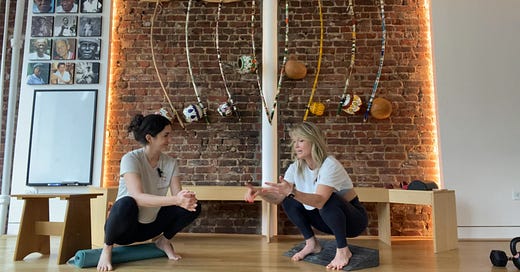If you have a love-hate relationship with squats, you aren’t alone. I’ve been exercising regularly for almost two decades, yet I still constantly feel like I’m “working on” my squats — not just increasing the weight I can move but trying to improve my depth, my ankle mobility, my capacity for going low without leaning forward too much. It’s hard!
For some insights and guidance on squats, I asked my friend (and boss, kind of!) Ana Costa to hang with me and answer about a million questions, and she very kindly agreed. Ana is a longtime personal trainer, mobility specialist, and Capoeira Angola practitioner and teacher, and she’s also the founder of Esquina, the beautiful studio where I teach Pilates and often film the Workout of the Week. During our conversation, she guided me through some great drills and approaches to squats, and I found myself doing my best and most comfortable squats probably ever.
If you’d like to see a transcript of our interview, you should be able to find it at the top of this page, just under my byline (near the Share button).
Ahead, some of my favorite tips and insights from our conversation about squats. (But if you have time, watch the video!)
Ankle mobility is everything!
Chances are good you don’t often think about your ankle mobility. But if you’re having issues with your squats, chances are also very good that limitations in ankle mobility could be the culprit.
Dorsiflexion is key: When you point your toes toward the floor and straighten through the top of your ankle and foot, that’s called plantar flexion. When you flex at the ankle to bring your toes toward your shin, that’s dorsiflexion. Dorsiflexion is the type of movement that’s most important for squats — for us to bend our hips and knees as deeply as possible while maintaining our center of gravity over our feet, the angle between our feet and shins has to be able to decrease.
Test your dorsiflexion: Make a fist with your thumb sticking out, then place that on the floor with your thumb against the wall. Place your toes against the pinky side of your hand. Release your hand. With your toes and knee pointing straight forward and your heel down, see how close to the wall you can bring your knee. This is a helpful test to check your ability to dorsiflex, and to assess how much your ankle mobility work is helping.
Practice and improve dorsiflexion: Check out some of the drills around 8:00 in the video above for some practical ways to work on your dorsiflexion.
Elevate your heels: If you do have ankle mobility limitations, you can use wedges, a rolled-up yoga mat, or weight plates to elevate your heels.
Squat-friendly habits and tools
To squat better, hang out in a squat. In many cultures, squatting is a normal position: You do it while cooking, waiting around, using the bathroom, even giving birth. Here in the U.S., most of us really only squat to sit down on a chair, in a car, or on the toilet, then stand back up. But the more time you spend squatting, the more comfortable you become in the position — and the easier it will feel when you load it with weights in an exercise context. Build your squat tolerance by working up to three minutes a day in a squat position: You can do it while you brush your teeth, watch TV, or even chop veggies.
Get stacked: Squatting with an upright, stacked alignment between the ribcage and pelvis (vs. flaring the ribs or excessive anterior pelvic tilt) improves breathing efficiency and pelvic floor control during the movement.
Squat barefoot: Overly padded shoes can inhibit the way our feet naturally engage and respond to load, and they can reduce ankle mobility. Spending more time barefoot in general can help, and training barefoot is a smart move. There’s also a strong connection between the strength and engagement of your feet and the function of your pelvic floor. Again, overly cushioned footwear can dampen foot activation, which in turn may reduce pelvic floor responsiveness during movements like squats. (If you’re at a gym and feel weird about it, just wear socks!) More on barefoot training here:
Experiment: There’s no one perfect way to squat, and everyone’s anatomy is a little bit different in terms of bone length, hip socket structure, etc. You may have an easier time squatting with your feet parallel and wider than hip width, or with your feet slightly turned out and directly under your hips, or some other setup entirely. Try squatting a bunch of different ways to see what works best for you.
Warm up your hips with CARs: Controlled Articular Rotations (which, if you’ve done my workouts, you’ve probably tried) help improve hip mobility, especially in your medial glutes, and can improve stability and range of motion in your squat.
Create external rotation torque: “Screw” your feet into the floor (without moving them) to engage your glutes and pelvic floor, which promotes stability in your squat. This also helps create tension through the pelvic floor, activating it during squats. This idea of external rotation torque is often more effective than the traditional “butt back” cue, which can disengage the pelvic floor.
Use a broomstick to check alignment: You can check your squat form by unscrewing the broom head from a broomstick, then placing the stick behind you, feeling it touch the back of your head, your upper back, and your tailbone. Hold it in place as you squat and notice if the points of contact change — and be curious about what needs to happen to keep them consistent as you move down and back up. (This is a great tool for deadlifts/hinges, too!)
Don’t forget to breathe: Managing intra-abdominal pressure through proper breathing (e.g., exhale on effort or slow exhale through the movement) can help power your squats and keep your pelvic floor working for you, especially under load or fatigue.
Dealing with pain and discomfort
Knee pain in squats doesn’t always mean a knee problem: Discomfort may show up in your knees, but it often actually stems from hip tightness or — yep — limited ankle mobility.
Snap, crackle, pop sounds are usually harmless: Joint noises like cracking and popping (aka crepitus!) are normal and not necessarily harmful unless they come along with pain and inflammation.
Wobbling and cramping are good, actually!: Mild discomfort like shakiness or cramping can mean that your central nervous system is in the process of learning something new. It’s a good thing for your progress and doesn’t mean you’re doing something wrong.
Your internal narrative matters: When you’re telling yourself “This sucks” while you squat, it will suck. It can feel a little cheesy, but during hard movements like squats, repeating to yourself, “I can do this!” or “This is easy!” can reduce your perceived pain and discomfort and actually make it easier.
I hope this was helpful and that you adore Ana as much as I do! If you’re in Brooklyn, please join us at Esquina for a class or personal training session sometime.
Let me know what other questions you have — and if there’s another exercise you’d like me to tackle next.
If you’re looking for guidance on lunges, check this out:
xo
Anna
















Share this post